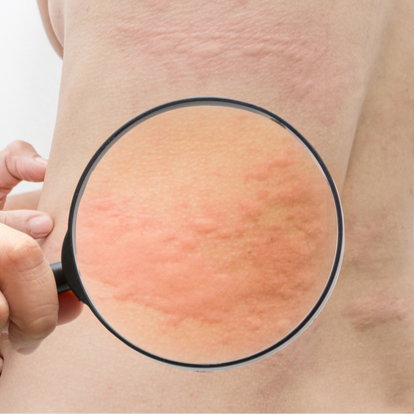 OVERVIEW
OVERVIEW
There are seemingly unlimited afflictions that can affect your skin. Hives are one of these dozens of conditions that strike the surface of the skin and cause varying degrees of itchiness, discomfort, redness, and swelling. Hives are typically caused by an allergic reaction and can be either chronic or acute, but the symptoms are very similar for both conditions.
What are Hives?
Hives are itchy, irritating, and sometimes painful welts or bumps that develop on the skin, seemingly at random. They’re typically red, vary in size, pattern, and severity, and resemble a rash. Hives are also known as urticaria and affect nearly 20% of the human population worldwide at some point in their lives.
While hives are extremely common, the exact cause of them is unknown. For some people, it seems to come and go without warning or notice. For others, however, there are definite triggers that activate hives in your skin, which then go away. Some of the known triggers of hives include:
- Foods that you’re allergic to
- Certain medications
- Insect bites or bee stings
- Physical activity, sun exposure, or exposure to pollen
- Latex and similar materials
- Bacterial or viral infections and blood transfusions
Many hive outbreaks are linked to allergies and often manifest when exposed to something you’re allergic to.
What are the Symptoms of Hives?
The physical symptoms of hives are painful and obvious. You will experience a series of red, rash-like welts, bumps, or abrasions on your skin. These welts and bumps will be seemingly random in size and pattern and may even change shape over time.
Other symptoms include severe itching, swelling, and irritation of the affected area. If hives occur on the inside of your throat or around your eyes, it can be extremely painful and debilitating.
Short-term hives, which occur randomly and are one-time, will appear suddenly and disappear within several days or weeks. Chronic hives, however, flare up without warning after exposure to known or unknown triggers and may take months to clear up.
How Are Hives Diagnosed?
An accurate diagnosis of hives requires seeing a medical professional. They will use a combination of your personal history and recent activity to determine whether or not you have hives and if there is a specific trigger. There are also blood tests and skin tests that your doctor or allergist can perform to determine what your hives are being triggered by.
Treatment Options for Hives
There are several solid treatment options to get rid of hives and manage the symptoms.
Antihistamines and other medications
Antihistamines are the best medication for mild to moderate cases of hives to relieve itching, pain, and swelling. Antihistamines can be purchased over the counter at your local pharmacy. However, if necessary, you can have a stronger antihistamine or other forms of medication prescribed to you by your doctor.
Home remedies
Although hives don’t have an exact cure, there are several home remedies you can utilize to ease the symptoms. Wearing loose clothing and applying anti-itch creams and lotions are excellent to ease the symptoms. You should also track when and where your hives appear and give that information to your doctor.
See an allergist
If you don’t see an allergist for your initial diagnosis, you should schedule an appointment with one. They will be able to determine what is causing your hives so that you can steer clear in the future.

